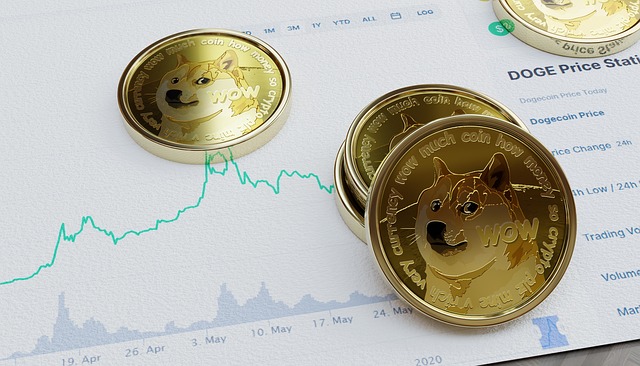How Does Crypto Futures Trading Work
Author: Jameson Richman Expert
Published On: 2025-09-12
Prepared by Jameson Richman and our team of experts with over a decade of experience in cryptocurrency and digital asset analysis. Learn more about us.
Understanding the intricacies of crypto futures trading is fundamental for investors seeking to capitalize on the volatility and dynamic movements of the cryptocurrency markets. Unlike traditional spot trading, where traders directly buy or sell the actual cryptocurrencies, futures trading involves entering into contractual agreements that specify the obligation to buy or sell a digital asset at a predetermined price at a future date. These derivative instruments offer unique opportunities for hedging, speculation, and leveraging capital, but also carry significant risks if not managed properly. In this comprehensive guide, drawing from extensive personal experience—including notable pitfalls, lessons learned, and successful strategies—I aim to provide a nuanced and in-depth understanding of how crypto futures trading operates, empowering you to navigate this complex financial landscape effectively.

Fundamentals of Crypto Futures Trading
Crypto futures are sophisticated financial derivatives whose value derives from an underlying cryptocurrency such as Bitcoin (BTC), Ethereum (ETH), or Ripple (XRP). When engaging in futures trading, traders enter into legally binding contracts to buy or sell a specified amount of the underlying asset at a fixed price—called the futures or strike price—at a designated future date or in the case of perpetual contracts, an indefinite period. These contracts can be settled either through cash payments, where profits or losses are credited or debited without transferring the actual asset, or through physical delivery, which involves transferring ownership of the digital asset—although, outside institutional trading, cash settlement dominates due to convenience and efficiency.
A pivotal feature of crypto futures is their flexibility to allow traders to take both long (buy) and short (sell) positions. This dual capability is particularly advantageous in the highly volatile crypto arena, enabling traders to profit from both upward and downward price movements. Perpetual futures contracts, which have no expiry date, closely replicate spot market behavior, allowing traders to hold positions indefinitely, provided they meet margin requirements. These contracts employ a funding rate mechanism to align their prices with the underlying spot price, effectively preventing significant divergence over time. Understanding these mechanics is key to executing effective strategies and managing risks in the constantly shifting crypto landscape.
It's crucial to distinguish futures from spot markets: futures are speculative instruments based on anticipated future prices and do not necessarily entail ownership of the actual asset—making them ideal for hedging and leveraged trading. This distinction impacts risk exposure and trading strategies significantly, especially during turbulent market phases, where leverage can amplify losses as readily as gains.
Leverage and Margin Trading: The Double-Edged Sword
Leverage is arguably the most enticing—and perilous—aspect of crypto futures trading. By borrowing funds from the trading platform, traders can amplify their exposure exponentially. For example, using 10x leverage allows control over a position worth ten times the invested capital. This magnification of position size can lead to outsized gains if the market moves favorably, but equally catastrophic losses if it moves against you. Early experiences in my trading journey underscored this reality—initially, overleveraging without adequate risk controls led to rapid capital erosion when markets reversed unexpectedly.
Effective leverage management is thus critical. Traders must understand margin requirements—initial and maintenance margins—and how liquidation levels operate. When a position's loss approaches the margin threshold, the platform can automatically liquidate the position to prevent further losses, often at unfavorable prices during volatile swings. To manage this double-edged sword, disciplined risk management is paramount. Key strategies include setting strict stop-loss orders to limit downside, choosing appropriate leverage levels aligned with your risk tolerance, and avoiding impulsive trades driven by emotion. Reputable platforms such as Binance, Bybit, and Bitget provide advanced margin controls, enabling traders to customize leverage and monitor liquidation risks meticulously. Employing these tools, along with diversification and position sizing, can help mitigate catastrophic losses during volatile swings. Regularly reviewing your margin levels and having a clear risk management plan are essential in preserving your trading capital over the long term.
Choosing the Right Platform: Features and Fees
Selecting an optimal trading platform is foundational to successful futures trading. Platforms like Binance, Mexc, Bitget, and Bybit offer different features tailored to varying experience levels—from beginner-friendly interfaces to advanced order types and analytics. For instance, Binance combines user accessibility with comprehensive educational resources (Binance Registration), making it suitable for newcomers, while Bitget and Bybit emphasize sophisticated trading tools, liquidity pools, and API integrations for seasoned traders. Additionally, some platforms offer features like auto-deleverage, cross-margin, isolated margin, and insurance funds—each impacting your trading flexibility and safety.
Understanding fee structures is equally critical—these include trading fees (maker and taker), funding rates, withdrawal costs, and liquidation fees. Hidden or poorly understood fees can erode profit margins over time. Many platforms offer promotional incentives like referral bonuses (Mexc Referral), which can offset initial costs but require careful review of terms. Comparing fee structures—such as flat fees versus tiered or volume-based fees—and platform security measures, including cold storage, two-factor authentication, and insurance funds, ensures that you select a platform aligning with your trading goals and risk appetite. Also, consider the platform’s liquidity, order execution speed, and customer support, as these factors critically influence trading efficiency and safety during high-stakes moves.

Technical Analysis and Market Psychology
Mastering technical analysis is essential for making informed futures trading decisions. My approach evolved from studying candlestick patterns, chart formations, and key momentum indicators—such as RSI, MACD, Bollinger Bands, and Fibonacci retracements. Combining these tools with an understanding of market psychology—like herd behavior, panic selling, or euphoria—enhances predictive accuracy and strategic timing.
For example, divergence between RSI and price action often signals potential reversals, prompting timely entries or exits. Over years, I refined my discipline by waiting for confirmation signals—such as volume spikes or pattern breakouts—rather than impulsively reacting to noise. Visualization techniques, backtesting strategies on historical data, and practicing with paper trading accounts further sharpen technical skills, helping to develop consistency in volatile environments. Incorporating concepts like volume weighted average price (VWAP), order book depth analysis, and market sentiment indices can add layers of insight, enabling traders to anticipate shifts before they become apparent in price charts.
Market News, Sentiment, and On-Chain Data
Crypto markets are profoundly influenced by external news, sentiment shifts, and macroeconomic factors. Regulatory developments, technological upgrades like network halvings or protocol upgrades, macroeconomic trends such as inflation reports, and social media trends can all precipitate rapid price changes. Staying informed through reputable news outlets (e.g., CoinDesk, CoinTelegraph), social media channels, and dedicated analytic platforms is crucial for timely decision-making.
Beyond external news, on-chain data provides deeper insights into market fundamentals. Metrics like Bitcoin hash rate, wallet activity, exchange inflows and outflows, and network congestion serve as real-time indicators of market sentiment. For example, rising on-chain activity and increased institutional inflows often precede bullish rallies, while large exchange withdrawals may indicate accumulation phases, hinting at potential upward moves. Conversely, heavy exchange deposits might suggest distribution or panic selling. Incorporating on-chain analytics—such as NVT ratio, MVRV, and realized cap—creates a holistic view, enabling more strategic positioning beyond simple chart analysis. These indicators can also help identify divergence between market fundamentals and price action, signaling potential reversals or trend continuations.
Strategies for Different Market Conditions
Adapting your trading approach to prevailing market conditions enhances profitability and reduces risk. In trending markets, momentum-based strategies like moving average crossovers, trendline breakouts, or breakout channels tend to perform well. Using tools like Ichimoku clouds or SuperTrend indicators can also help confirm trend strength. Conversely, in sideways or consolidating phases, range trading—buying near support and selling near resistance—can be more effective. Oscillators such as Stochastic or RSI can aid in identifying overbought or oversold levels within ranges.
Additionally, clarifying your trading style—scalping, day trading, swing trading, or long-term investing—is essential. Scalping demands rapid execution and tight risk controls, suitable for high-volume, liquid markets. Swing trading involves holding positions over days or weeks, capitalizing on larger swings, often relying on a combination of technical and fundamental analysis. Position trading focuses on long-term trends, often influenced by macroeconomic factors and technological developments. Matching your style with your risk tolerance, time availability, and skill level fosters sustainable growth and emotional stability. Developing a comprehensive trading plan tailored to current market phase—be it bullish, bearish, or sideways—ensures disciplined execution and reduces impulsive decision-making.

Perpetual Contracts and Funding Rates
Perpetual futures are the dominant derivatives product in crypto markets due to their flexibility and continuous trading nature. They lack expiry dates but incorporate a funding rate mechanism—periodic payments exchanged between longs and shorts—to keep the futures price in line with the underlying spot price. When market sentiment is bullish, funding rates tend to be positive, with longs paying shorts; during bearish phases, the rates can turn negative, with shorts paying longs.
Managing the costs associated with funding rates is crucial. During periods of high volatility or extended trends, these payments can accumulate significantly, impacting overall profitability. Strategies include timing trades around funding periods, using limit orders to optimize entries and exits, and adjusting leverage to account for potential funding costs. Monitoring funding rates often provides insights into market sentiment—persistent positive rates often indicate bullish dominance, while negative rates suggest bearish sentiment. Some traders use funding rate trends as contrarian signals—extremely high rates may signal excessive bullishness, risking a correction, whereas negative rates could imply overselling and potential reversals.
On-Chain Data and Long-Term Market Trends
Incorporating long-term on-chain data analysis enables traders and investors to understand broader adoption and technological progress. Metrics such as Bitcoin’s hash rate, active addresses, transaction volumes, and exchange inflows/outflows reflect network security, user engagement, and accumulation/distribution patterns. Developments like the Lightning Network, second-layer solutions, or protocol upgrades (e.g., Ethereum’s shift to proof-of-stake) influence long-term valuation and usability.
Monitoring macroeconomic indicators—like inflation rates, monetary policy changes, and global economic health—also informs strategic positioning. Combining these insights with industry forecasts and expert analyses allows for a balanced view—facilitating informed decisions whether you are day trading or planning for long-term holds. Regular review of on-chain fundamentals helps contextualize short-term price fluctuations and align trading strategies with evolving market realities. For example, increasing network activity amidst macroeconomic instability may signal accumulation, while declining hash rates could warn of security concerns or capitulation phases.
Developing a Balanced Trading Approach
After years of experimenting, I advocate for a balanced approach that synthesizes technical mastery, fundamental awareness, disciplined risk management, and continuous learning. Patience and adaptability are vital—resisting impulsive reactions during volatile swings and consistently refining strategies based on market feedback. Engaging with crypto communities through forums, mentorship, and social channels provides diverse perspectives and keeps your knowledge fresh. Utilizing tools like trading journals, performance analytics, and regular post-trade reviews fosters self-awareness and ongoing improvement.
Maintaining a disciplined routine—setting achievable goals, defining risk parameters, and sticking to a trading plan—protects your capital and enhances longevity. Incorporate continuous education through webinars, courses, and industry publications. Remember, successful crypto futures trading isn't about chasing every move but about understanding the environment, managing risk effectively, and evolving with the market. A well-rounded, disciplined approach grounded in experience and ongoing learning sets the foundation for sustainable success in this challenging yet rewarding market.

Conclusion
Crypto futures trading offers substantial profit opportunities but demands a disciplined, informed approach. Success hinges on understanding contract mechanics, effective risk and leverage management, blending technical and fundamental analysis, and staying abreast of market developments. My journey underscores that continuous learning, strategic adaptation, and community engagement transform setbacks into valuable lessons. By prioritizing education, practicing diligently, and remaining flexible amidst rapid market changes, you can develop a sustainable and profitable futures trading practice in the evolving crypto landscape.